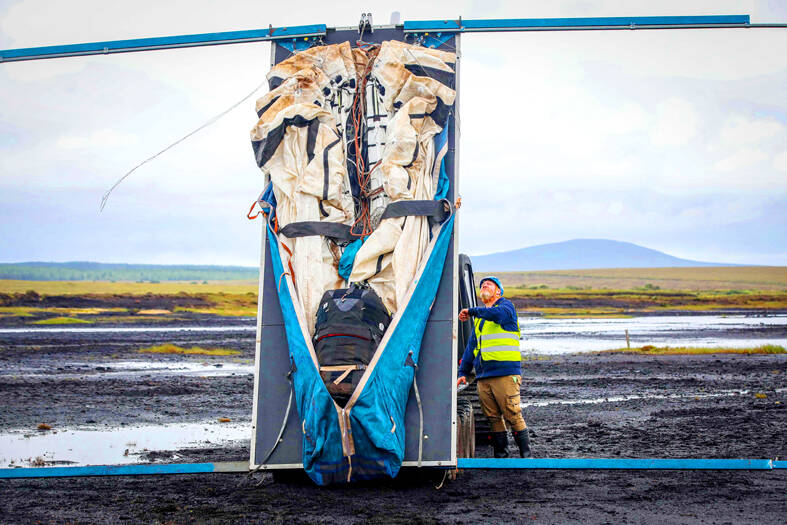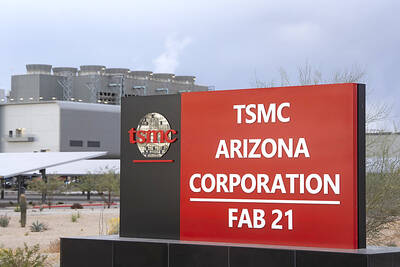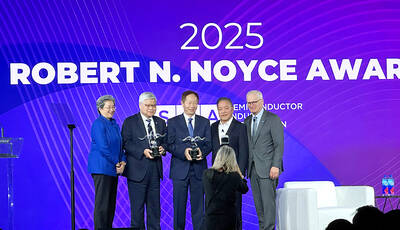On Ireland’s blustery western seaboard, researchers are gleefully flying giant kites — not for fun, but in the hope of generating renewable electricity and sparking a “revolution” in wind energy.
“We use a kite to capture the wind and a generator at the bottom of it that captures the power,” said Padraic Doherty of Kitepower, the Dutch firm behind the venture.
At its test site in operation since September 2023 near the small town of Bangor Erris, the team transports the vast 60-square-meter kite from a hangar across the lunar-like bogland to a generator. The kite is then attached by a cable tether to the machine and acts like a “yo-yo or fishing reel,” Doherty said.

Photo: AFP
“It gets cast out and flies up, the tether pulls it back in, over and over again, creating energy,” he said, testing the kite’s ropes and pulleys before a flight.
The sparsely populated spot near the stormy Atlantic coast is the world’s first designated airborne renewable energy test site, and although the idea is still small in scale, it could yet prove to be a mighty plan as Ireland seeks to cut its reliance on fossil fuels such as oil and gas.
“We are witnessing a revolution in wind energy,” said Andrei Luca, operations head at Kitepower, a zero-emissions energy solutions spin-off from the Delft University of Technology, a Dutch public university.
“It took nearly 25 years for wind turbines to evolve from 30-kilowatt prototypes to megawatt scale, and decades to offshore wind farms we see today,” he added.
TECHNOLOGY
The system flies autonomously, driven by software developed at the university in the Netherlands, but Doherty acts as the kite’s “pilot” on the ground, monitoring its flight path for efficiency. The kite flies up about 400m and reels in to about 190m, generating about 30 kilowatts for storage.
The force spins “like a dynamo on a bike,” Doherty said, adding that “it generates up to two-and-a-half tonnes of force through each turn.”
The electricity is stored in batteries, similar to solar photovoltaic systems, with the kite able to fully charge a 336-kilowatt-hour battery.
“That’s a meaningful amount of energy, sufficient for powering a remote outpost, a small island, polar station or even a construction site,” Luca said. “Add additional kites and we can power a bigger island.”
MOBILE, FLEXIBLE
According to Doherty, a chief advantage of the kite system is its flexibility and swift start-up capability.
“We can set up in 24 hours and can bring it anywhere, it’s super mobile and doesn’t need expensive, time and energy-consuming turbine foundations to be built,” he said.
A kite system is “way less invasive on the landscape [than wind turbines], produces clean energy and doesn’t need a supply chain of fuel to keep running,” he added.
During January’s Storm Eowyn, which caused widespread and long-lasting power outages in Ireland, the system showed its value in Bangor Erris, Luca said. “Paired with a battery, it provided uninterrupted electricity before, during and after the storm.”
Ireland’s wind energy sector has long been touted as full of potential, but progress on large-scale delivery of onshore and offshore turbines has been held up by planning delays and electricity grid capacity constraints.
GOVERNMENT TARGETS
The Irish government has set ambitious targets for offshore wind energy to deliver 20 gigawatts of energy by 2040 and at least 37 gigawatts by 2050.
Irish wind farms last year provided about one-third of the country’s electricity, said Wind Energy Ireland, a lobby group for the sector. This compares with the UK, where, according to trade association RenewableUK, wind energy from the country’s combined wind farms first reached 20 gigawatts in November 2022.
The ability of airborne wind energy (AWE) systems to harness high-altitude winds with relatively low infrastructure requirements “makes them particularly suitable for remote, offshore or mobile applications,” said Mahdi Salari, an AWE researcher at University College Cork.
CHALLENGES
Kitepower would face challenges on “regulation, safety and system reliability,” but such technology could plug gaps in places where “land availability, costs or logistical constraints hinder the deployment of traditional wind turbines,” he said.
By the 2030s, “I expect AWE to contribute meaningfully to diversified, flexible and distributed renewable energy networks,” he added.

Shiina Ito has had fewer Chinese customers at her Tokyo jewelry shop since Beijing issued a travel warning in the wake of a diplomatic spat, but she said she was not concerned. A souring of Tokyo-Beijing relations this month, following remarks by Japanese Prime Minister Sanae Takaichi about Taiwan, has fueled concerns about the impact on the ritzy boutiques, noodle joints and hotels where holidaymakers spend their cash. However, businesses in Tokyo largely shrugged off any anxiety. “Since there are fewer Chinese customers, it’s become a bit easier for Japanese shoppers to visit, so our sales haven’t really dropped,” Ito

The number of Taiwanese working in the US rose to a record high of 137,000 last year, driven largely by Taiwan Semiconductor Manufacturing Co’s (TSMC, 台積電) rapid overseas expansion, according to government data released yesterday. A total of 666,000 Taiwanese nationals were employed abroad last year, an increase of 45,000 from 2023 and the highest level since the COVID-19 pandemic, data from the Directorate-General of Budget, Accounting and Statistics (DGBAS) showed. Overseas employment had steadily increased between 2009 and 2019, peaking at 739,000, before plunging to 319,000 in 2021 amid US-China trade tensions, global supply chain shifts, reshoring by Taiwanese companies and

Taiwan Semiconductor Manufacturing Co (TSMC, 台積電) received about NT$147 billion (US$4.71 billion) in subsidies from the US, Japanese, German and Chinese governments over the past two years for its global expansion. Financial data compiled by the world’s largest contract chipmaker showed the company secured NT$4.77 billion in subsidies from the governments in the third quarter, bringing the total for the first three quarters of the year to about NT$71.9 billion. Along with the NT$75.16 billion in financial aid TSMC received last year, the chipmaker obtained NT$147 billion in subsidies in almost two years, the data showed. The subsidies received by its subsidiaries —

Taiwan Semiconductor Manufacturing Co (TSMC) Chairman C.C. Wei (魏哲家) and the company’s former chairman, Mark Liu (劉德音), both received the Robert N. Noyce Award -- the semiconductor industry’s highest honor -- in San Jose, California, on Thursday (local time). Speaking at the award event, Liu, who retired last year, expressed gratitude to his wife, his dissertation advisor at the University of California, Berkeley, his supervisors at AT&T Bell Laboratories -- where he worked on optical fiber communication systems before joining TSMC, TSMC partners, and industry colleagues. Liu said that working alongside TSMC